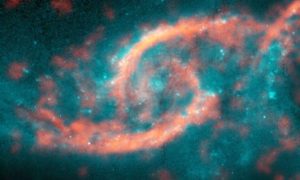interazioni galattiche
La Galassia Ruota di Carro
A circa 500 milioni di anni luce di distanza nella costellazione dello Scultore, la forma della Galassia Ruota di Carro (Cartwheel Galaxy) è il risultato di una collisione galattica violenta. Una galassia più piccola è passata attraverso il disco di una grande galassia e ha prodotto onde d’urto che hanno travolto gas e polveri, in modo simile alle increspature prodotte quando un sasso cade in un lago. Lo scontro titanico ha innescato nella regione intensi fenomeni di formazione stellare. Continua a leggere
Uno tsunami di gas e stelle forma un “occhio” galattico
 Gli astronomi utilizzando l’Atacama Large Millimeter/submillimeter Array (ALMA) hanno individuato nel disco di una galassia a spirale nota come IC 2163 un vero e proprio “tsunami” di stelle e gas generato dallo scontro tra due galassie. Quest’onda colossale di materiale, innescata quando IC 2163 ha speronato un’altra galassia a spirale chiamata NGC 2207, ha prodotto archi rilucenti di intensa formazione stellare che sembrano assumere l’aspetto di un occhio dotato di palpebre. Continua a leggere
Gli astronomi utilizzando l’Atacama Large Millimeter/submillimeter Array (ALMA) hanno individuato nel disco di una galassia a spirale nota come IC 2163 un vero e proprio “tsunami” di stelle e gas generato dallo scontro tra due galassie. Quest’onda colossale di materiale, innescata quando IC 2163 ha speronato un’altra galassia a spirale chiamata NGC 2207, ha prodotto archi rilucenti di intensa formazione stellare che sembrano assumere l’aspetto di un occhio dotato di palpebre. Continua a leggere
